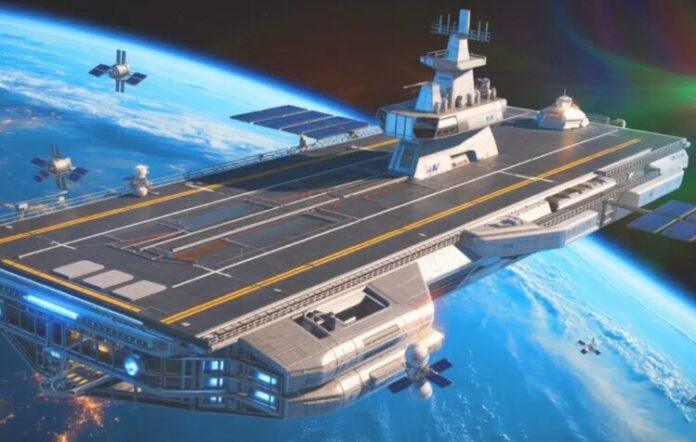Space Force Orbital Warship Carrier Concept Overview: In the 2040s, the domain of human conflict has irrevocably expanded. With Earth’s orbit cluttered with critical military, commercial, and civilian satellites, the need for persistent presence and rapid response has birthed a new class of vessel: the Orbital Warship Carrier. The envisioned “Sentinel-Class” is not a naval ship in space but a dedicated mobile operations centre, designed for dominance in the high frontier.
1. Mission Profile: Why a Carrier?
A carrier’s role is not to engage in direct ship-to-ship combat but to project power through its assets. The Sentinel-Class fulfills several critical missions:
- Space Domain Awareness & Command & Control (C2): Acting as a forward-deployed command node, it integrates data from a vast network of sensors across cislunar space, providing an unrivaled tactical picture.
- On-Dorbit Security & Defense: Its deployable craft can rapidly intercept and inspect suspicious objects, defend allied satellites from attack, and neutralize hostile space assets.
- Orbital Denial and Control: In a conflict, it can project a “bubble” of control, denying an adversary the use of specific orbital regimes.
- Rapid Reconnaissance & Deployment: It can deploy sensor platforms, repair drones, or specialised craft for specific missions anywhere in its operational sphere.
- Strategic Deterrence: Its mere presence complicates an adversary’s calculations, deterring aggressive acts in space space force orbital warship carrier.
2. Design & Architecture: Form Follows Function
The design of the Sentinel-Class is a radical departure from science fiction, prioritizing function in the harsh environment of space.
| Feature | Description | Rationale |
|---|---|---|
| Modular Spine | A central, long truss structure made of advanced composites. | Serves as the primary structural element, allowing for different mission modules to be attached, replaced, or upgraded. Provides a long baseline for power and sensor systems. |
| Habitation Ring` | A rotating torus (donut) positioned amidships. | Generates artificial gravity via centrifugal force to maintain crew health (bone density, muscle mass) during long-duration deployments. Contains crew quarters, mess, and medical facilities. |
| Payload Bays | Multiple standardized ports along the spine. | Functions like the hangar bay of a sea-going carrier. Instead of aircraft, it houses and services XS-72 “Space Raptor” spaceplanes, Orbital Transfer Vehicles (OTVs), and specialized mission pods. |
| Power & Propulsion | – A compact nuclear fission reactor (behind a robust radiation shield). – Arrays of VASIMR (Variable Specific Impulse Magnetoplasma Rocket) thrusters. – Conventional chemical thrusters for RCS (Reaction Control System). | The reactor provides megawatts of power for sensors, life support, and electric propulsion. VASIMR offers high-efficiency, continuous thrust for orbital adjustments and trans-lunar injections. |
| Armament | Defensive: Point-defense lasers, kinetic intercept systems (railguns). Offensive: Not a primary design focus. | Armament is designed for self-defense against missiles, drones, and small craft. Its primary “weapons” are the craft it deploys. A larger, spinal-mounted laser might be used for disabling satellite components at range. |
| Sensor Suite | – Long-range AESA (Active Electronically Scanned Array) radar. – Multi-spectral telescopic sensors. – LiDAR and passive ESM (Electronic Support Measures). | To maintain a comprehensive “Common Operational Picture” (COP) of thousands of objects in near-Earth space, from satellites to debris. |
Conceptual Image Description: A long, skeletal truss structure dominates the center. Amidships, a glowing, rotating habitation ring spins slowly. Docked along the spine are several sleek, angular spaceplanes and boxy mission pods. At the “stern,” large radiators glow with heat, and the blue plume of a VASIMR thruster is visible. The entire vessel is silhouetted against the sunlit curve of Earth.
3. The Air Wing: Fangs of the Sentinel
The carrier’s effectiveness lies in its deployable assets, each a specialist:
- XS-72 “Space Raptor” (Multi-Role Spaceplane):
- Role: Inspection, interception, crew transport, limited strike.
- Capabilities: Reusable, equipped with manipulator arms, non-kinetic jammers, and a small internal bay for micro-satellites or interceptors.
- “Watchdog” OTV (Orbital Transfer Vehicle):
- Role: High-delta-v platform for deep-space missions.
- Capabilities: A “tug” used to reposition large satellites, retrieve objects in unusual orbits, or deploy sensor platforms in high orbits. Unmanned and capable of multi-month autonomous operations.
- “Ferret” Inspection Drone:
- Role: Close-proximity satellite inspection.
- Capabilities: Small, agile, and stealthy. Used for covertly examining adversary satellites to determine their purpose and capabilities.
- “Aegis” Defense Pod:
- Role: Point-defense and area denial.
- Capabilities: Once deployed, it unfolds to reveal a powerful laser and a battery of small kinetic “shotgun” rounds, creating a defensive screen for the carrier or high-value assets.
4. Crew & Operations: Life on the High Frontier
- Crew Complement: ~120 personnel (a mix of USSF officers, enlisted specialists, and civilian contractors).
- Watch Cycles: The habitation ring allows for a semi-terrestrial lifestyle, with 8-hour watches followed by time in “gravity” for meals and rest, drastically reducing fatigue.
- Command Structure: The vessel is commanded by a Colonel (O-6), with a dedicated “Air Group” commander for the deployed assets.
5. Challenges & Strategic Implications
The path to building a Sentinel-Class is fraught with immense challenges:
- Cost: The development and launch costs would be measured in hundreds of billions, if not trillions, of dollars.
- In-Orbit Assembly: Such a large structure cannot be launched in one piece. It would require years of assembly by specialized OTVs and robotic systems at a dedicated orbital dock, likely at a Lagrange point.
- Vulnerability: Despite its defenses, it is a large, high-value target. It would require a constant escort of defensive platforms and would be a primary target in any peer conflict.
- The Treaty Problem: The Outer Space Treaty of 1967 prohibits weapons of mass destruction in orbit but is ambiguous about conventional weapons. Deploying an armed carrier would trigger a major international diplomatic crisis and likely a new space arms race.
Conclusion:
The Space Force Orbital Warship Carrier is not a near-term reality. However, as a conceptual endpoint of current trends in military space operations, it is a powerful tool for strategic thought. It forces planners to consider the logistics, tactics, and grand strategy of a future where control of Earth’s orbit is as decisive as control of the seas once was. The Sentinel-Class is a vision of a future where the Space Force evolves from a service that supports terrestrial operations to one that commands its own ultimate high ground.



